Health Economics Report: Analysis of HIV Prevention Programs in India
VerifiedAdded on 2022/12/29
|9
|3199
|36
Report
AI Summary
This report provides a comprehensive analysis of the health economics surrounding HIV prevention and management in India. It begins with an introduction to health economics and its relevance to HIV, followed by a background on the HIV epidemic in India, highlighting prevalence rates, trends, and key affected populations. The discussion section delves into the National AIDS Control Programme (NACP), its evolution, and the financial support it receives, including an evaluation of its effectiveness and impact. The report examines the cost-effectiveness of various HIV prevention strategies, such as Avahan, and the impact of antiretroviral treatment (ART) on costs. The report also analyzes healthcare financing models and recommends strategies to reduce the financial burden on HIV-affected individuals and their families, emphasizing the need for comprehensive healthcare services, financial planning, and home-based care. It concludes with recommendations for future HIV treatment and care programs, focusing on a holistic approach that considers the financial well-being of those affected by HIV.
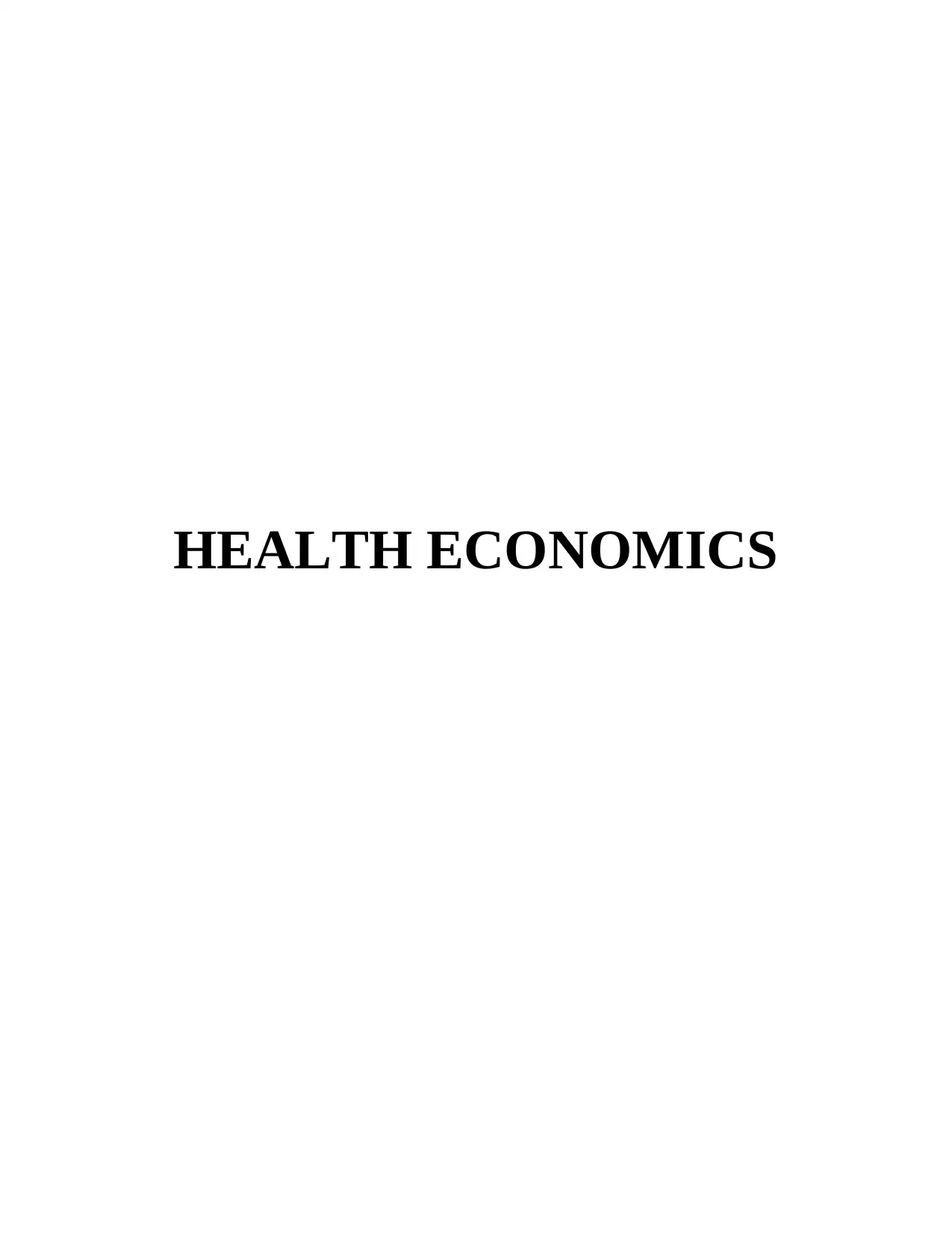
HEALTH ECONOMICS
Paraphrase This Document
Need a fresh take? Get an instant paraphrase of this document with our AI Paraphraser
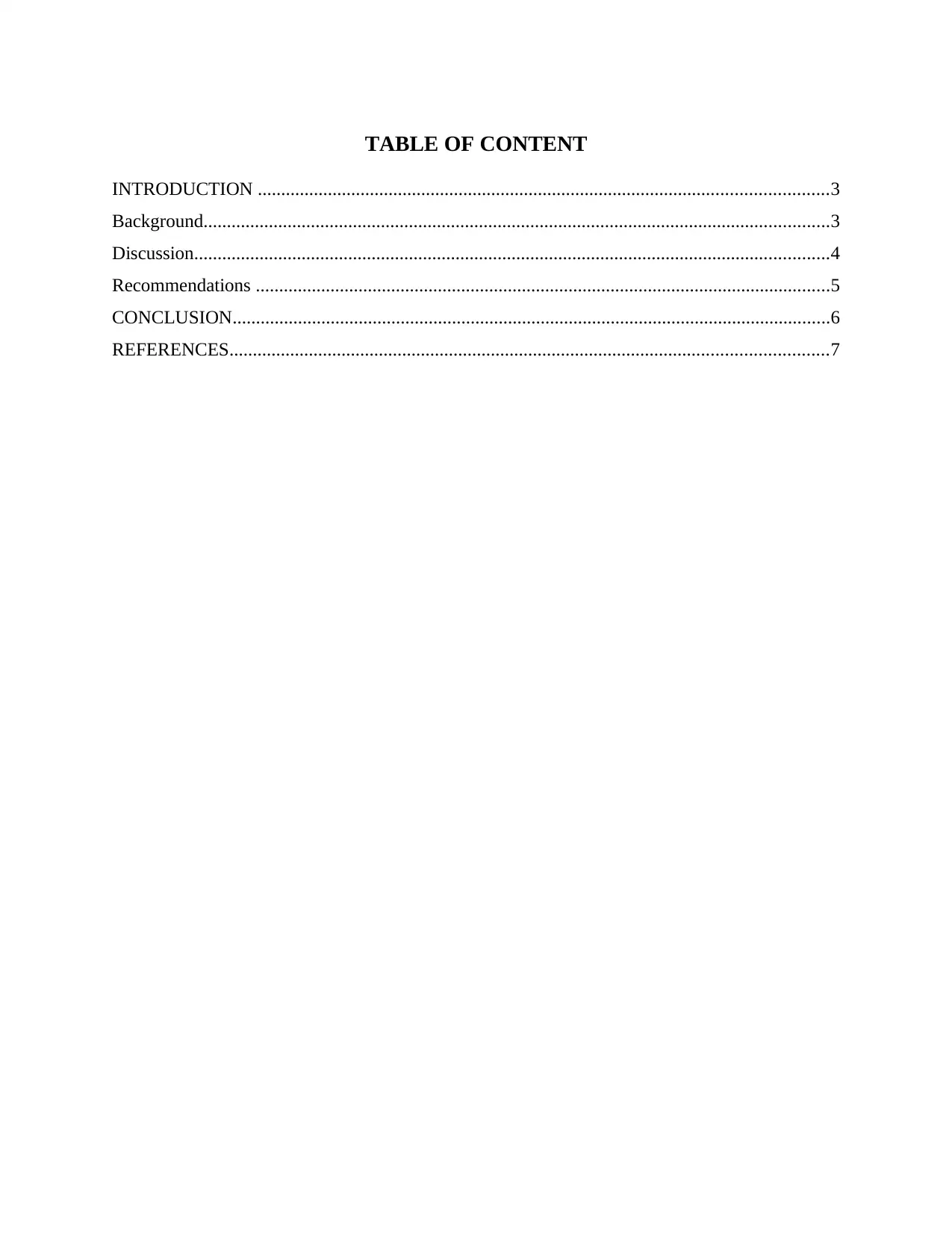
TABLE OF CONTENT
INTRODUCTION ..........................................................................................................................3
Background......................................................................................................................................3
Discussion........................................................................................................................................4
Recommendations ...........................................................................................................................5
CONCLUSION................................................................................................................................6
REFERENCES................................................................................................................................7
INTRODUCTION ..........................................................................................................................3
Background......................................................................................................................................3
Discussion........................................................................................................................................4
Recommendations ...........................................................................................................................5
CONCLUSION................................................................................................................................6
REFERENCES................................................................................................................................7
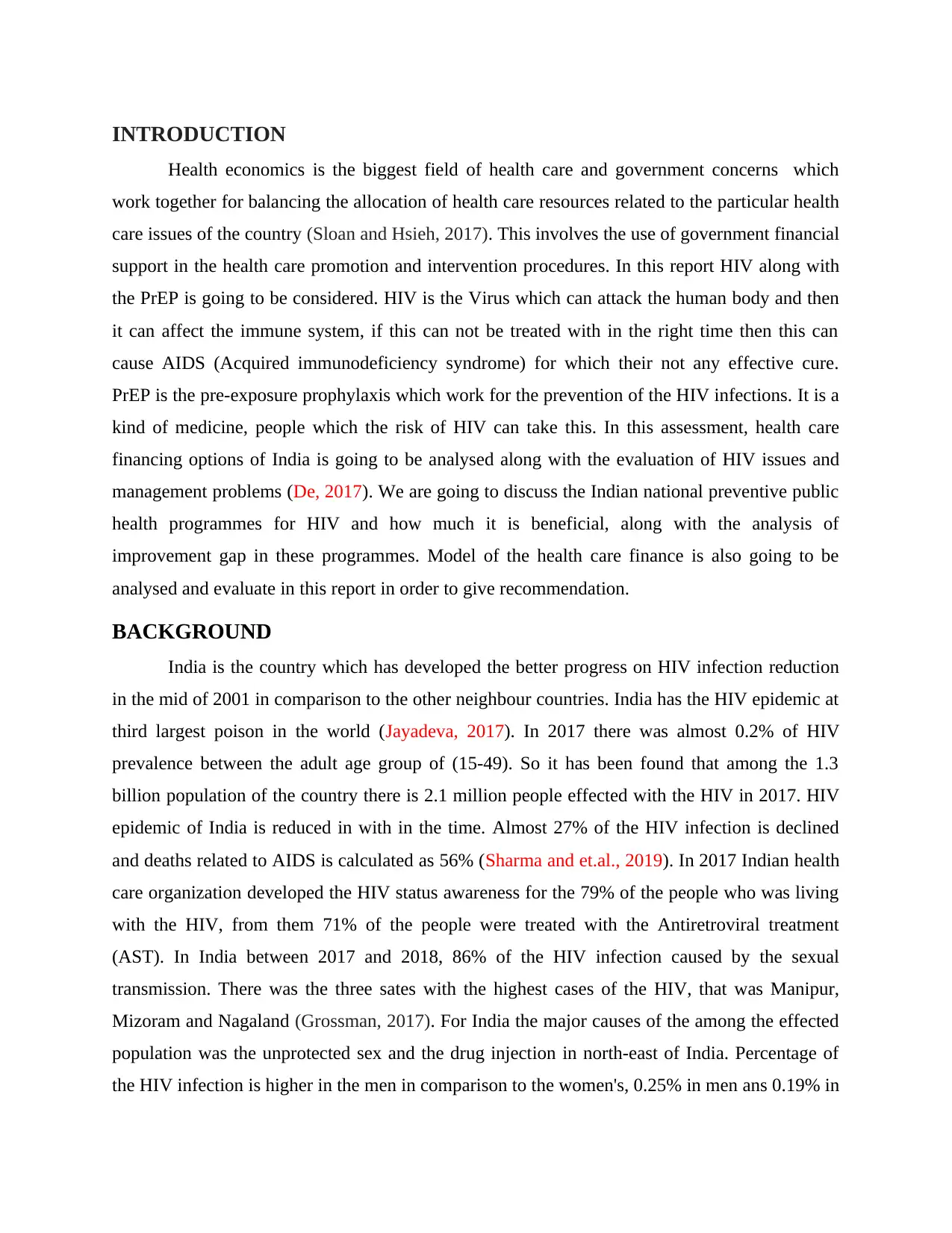
INTRODUCTION
Health economics is the biggest field of health care and government concerns which
work together for balancing the allocation of health care resources related to the particular health
care issues of the country (Sloan and Hsieh, 2017). This involves the use of government financial
support in the health care promotion and intervention procedures. In this report HIV along with
the PrEP is going to be considered. HIV is the Virus which can attack the human body and then
it can affect the immune system, if this can not be treated with in the right time then this can
cause AIDS (Acquired immunodeficiency syndrome) for which their not any effective cure.
PrEP is the pre-exposure prophylaxis which work for the prevention of the HIV infections. It is a
kind of medicine, people which the risk of HIV can take this. In this assessment, health care
financing options of India is going to be analysed along with the evaluation of HIV issues and
management problems (De, 2017). We are going to discuss the Indian national preventive public
health programmes for HIV and how much it is beneficial, along with the analysis of
improvement gap in these programmes. Model of the health care finance is also going to be
analysed and evaluate in this report in order to give recommendation.
BACKGROUND
India is the country which has developed the better progress on HIV infection reduction
in the mid of 2001 in comparison to the other neighbour countries. India has the HIV epidemic at
third largest poison in the world (Jayadeva, 2017). In 2017 there was almost 0.2% of HIV
prevalence between the adult age group of (15-49). So it has been found that among the 1.3
billion population of the country there is 2.1 million people effected with the HIV in 2017. HIV
epidemic of India is reduced in with in the time. Almost 27% of the HIV infection is declined
and deaths related to AIDS is calculated as 56% (Sharma and et.al., 2019). In 2017 Indian health
care organization developed the HIV status awareness for the 79% of the people who was living
with the HIV, from them 71% of the people were treated with the Antiretroviral treatment
(AST). In India between 2017 and 2018, 86% of the HIV infection caused by the sexual
transmission. There was the three sates with the highest cases of the HIV, that was Manipur,
Mizoram and Nagaland (Grossman, 2017). For India the major causes of the among the effected
population was the unprotected sex and the drug injection in north-east of India. Percentage of
the HIV infection is higher in the men in comparison to the women's, 0.25% in men ans 0.19% in
Health economics is the biggest field of health care and government concerns which
work together for balancing the allocation of health care resources related to the particular health
care issues of the country (Sloan and Hsieh, 2017). This involves the use of government financial
support in the health care promotion and intervention procedures. In this report HIV along with
the PrEP is going to be considered. HIV is the Virus which can attack the human body and then
it can affect the immune system, if this can not be treated with in the right time then this can
cause AIDS (Acquired immunodeficiency syndrome) for which their not any effective cure.
PrEP is the pre-exposure prophylaxis which work for the prevention of the HIV infections. It is a
kind of medicine, people which the risk of HIV can take this. In this assessment, health care
financing options of India is going to be analysed along with the evaluation of HIV issues and
management problems (De, 2017). We are going to discuss the Indian national preventive public
health programmes for HIV and how much it is beneficial, along with the analysis of
improvement gap in these programmes. Model of the health care finance is also going to be
analysed and evaluate in this report in order to give recommendation.
BACKGROUND
India is the country which has developed the better progress on HIV infection reduction
in the mid of 2001 in comparison to the other neighbour countries. India has the HIV epidemic at
third largest poison in the world (Jayadeva, 2017). In 2017 there was almost 0.2% of HIV
prevalence between the adult age group of (15-49). So it has been found that among the 1.3
billion population of the country there is 2.1 million people effected with the HIV in 2017. HIV
epidemic of India is reduced in with in the time. Almost 27% of the HIV infection is declined
and deaths related to AIDS is calculated as 56% (Sharma and et.al., 2019). In 2017 Indian health
care organization developed the HIV status awareness for the 79% of the people who was living
with the HIV, from them 71% of the people were treated with the Antiretroviral treatment
(AST). In India between 2017 and 2018, 86% of the HIV infection caused by the sexual
transmission. There was the three sates with the highest cases of the HIV, that was Manipur,
Mizoram and Nagaland (Grossman, 2017). For India the major causes of the among the effected
population was the unprotected sex and the drug injection in north-east of India. Percentage of
the HIV infection is higher in the men in comparison to the women's, 0.25% in men ans 0.19% in
⊘ This is a preview!⊘
Do you want full access?
Subscribe today to unlock all pages.

Trusted by 1+ million students worldwide
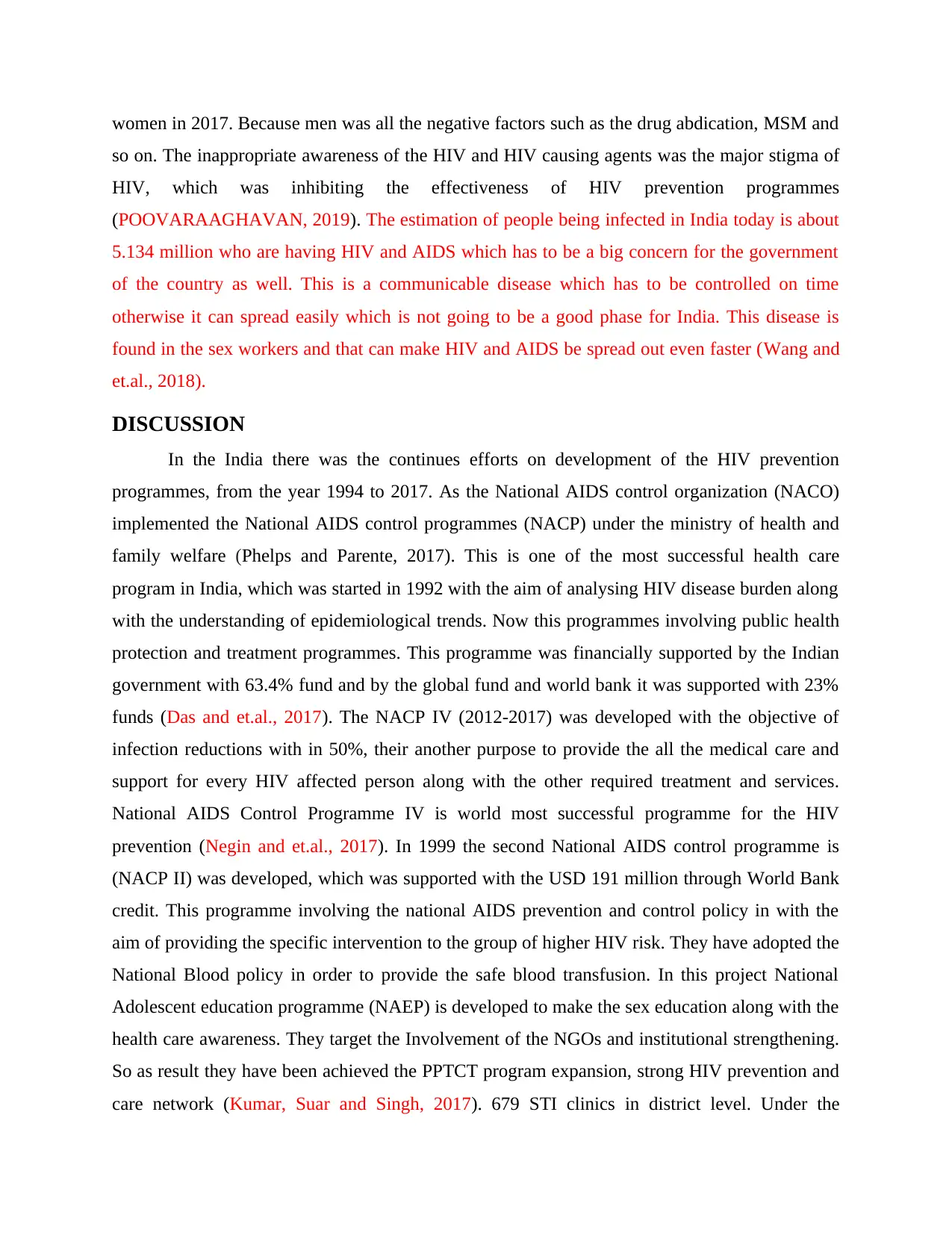
women in 2017. Because men was all the negative factors such as the drug abdication, MSM and
so on. The inappropriate awareness of the HIV and HIV causing agents was the major stigma of
HIV, which was inhibiting the effectiveness of HIV prevention programmes
(POOVARAAGHAVAN, 2019). The estimation of people being infected in India today is about
5.134 million who are having HIV and AIDS which has to be a big concern for the government
of the country as well. This is a communicable disease which has to be controlled on time
otherwise it can spread easily which is not going to be a good phase for India. This disease is
found in the sex workers and that can make HIV and AIDS be spread out even faster (Wang and
et.al., 2018).
DISCUSSION
In the India there was the continues efforts on development of the HIV prevention
programmes, from the year 1994 to 2017. As the National AIDS control organization (NACO)
implemented the National AIDS control programmes (NACP) under the ministry of health and
family welfare (Phelps and Parente, 2017). This is one of the most successful health care
program in India, which was started in 1992 with the aim of analysing HIV disease burden along
with the understanding of epidemiological trends. Now this programmes involving public health
protection and treatment programmes. This programme was financially supported by the Indian
government with 63.4% fund and by the global fund and world bank it was supported with 23%
funds (Das and et.al., 2017). The NACP IV (2012-2017) was developed with the objective of
infection reductions with in 50%, their another purpose to provide the all the medical care and
support for every HIV affected person along with the other required treatment and services.
National AIDS Control Programme IV is world most successful programme for the HIV
prevention (Negin and et.al., 2017). In 1999 the second National AIDS control programme is
(NACP II) was developed, which was supported with the USD 191 million through World Bank
credit. This programme involving the national AIDS prevention and control policy in with the
aim of providing the specific intervention to the group of higher HIV risk. They have adopted the
National Blood policy in order to provide the safe blood transfusion. In this project National
Adolescent education programme (NAEP) is developed to make the sex education along with the
health care awareness. They target the Involvement of the NGOs and institutional strengthening.
So as result they have been achieved the PPTCT program expansion, strong HIV prevention and
care network (Kumar, Suar and Singh, 2017). 679 STI clinics in district level. Under the
so on. The inappropriate awareness of the HIV and HIV causing agents was the major stigma of
HIV, which was inhibiting the effectiveness of HIV prevention programmes
(POOVARAAGHAVAN, 2019). The estimation of people being infected in India today is about
5.134 million who are having HIV and AIDS which has to be a big concern for the government
of the country as well. This is a communicable disease which has to be controlled on time
otherwise it can spread easily which is not going to be a good phase for India. This disease is
found in the sex workers and that can make HIV and AIDS be spread out even faster (Wang and
et.al., 2018).
DISCUSSION
In the India there was the continues efforts on development of the HIV prevention
programmes, from the year 1994 to 2017. As the National AIDS control organization (NACO)
implemented the National AIDS control programmes (NACP) under the ministry of health and
family welfare (Phelps and Parente, 2017). This is one of the most successful health care
program in India, which was started in 1992 with the aim of analysing HIV disease burden along
with the understanding of epidemiological trends. Now this programmes involving public health
protection and treatment programmes. This programme was financially supported by the Indian
government with 63.4% fund and by the global fund and world bank it was supported with 23%
funds (Das and et.al., 2017). The NACP IV (2012-2017) was developed with the objective of
infection reductions with in 50%, their another purpose to provide the all the medical care and
support for every HIV affected person along with the other required treatment and services.
National AIDS Control Programme IV is world most successful programme for the HIV
prevention (Negin and et.al., 2017). In 1999 the second National AIDS control programme is
(NACP II) was developed, which was supported with the USD 191 million through World Bank
credit. This programme involving the national AIDS prevention and control policy in with the
aim of providing the specific intervention to the group of higher HIV risk. They have adopted the
National Blood policy in order to provide the safe blood transfusion. In this project National
Adolescent education programme (NAEP) is developed to make the sex education along with the
health care awareness. They target the Involvement of the NGOs and institutional strengthening.
So as result they have been achieved the PPTCT program expansion, strong HIV prevention and
care network (Kumar, Suar and Singh, 2017). 679 STI clinics in district level. Under the
Paraphrase This Document
Need a fresh take? Get an instant paraphrase of this document with our AI Paraphraser
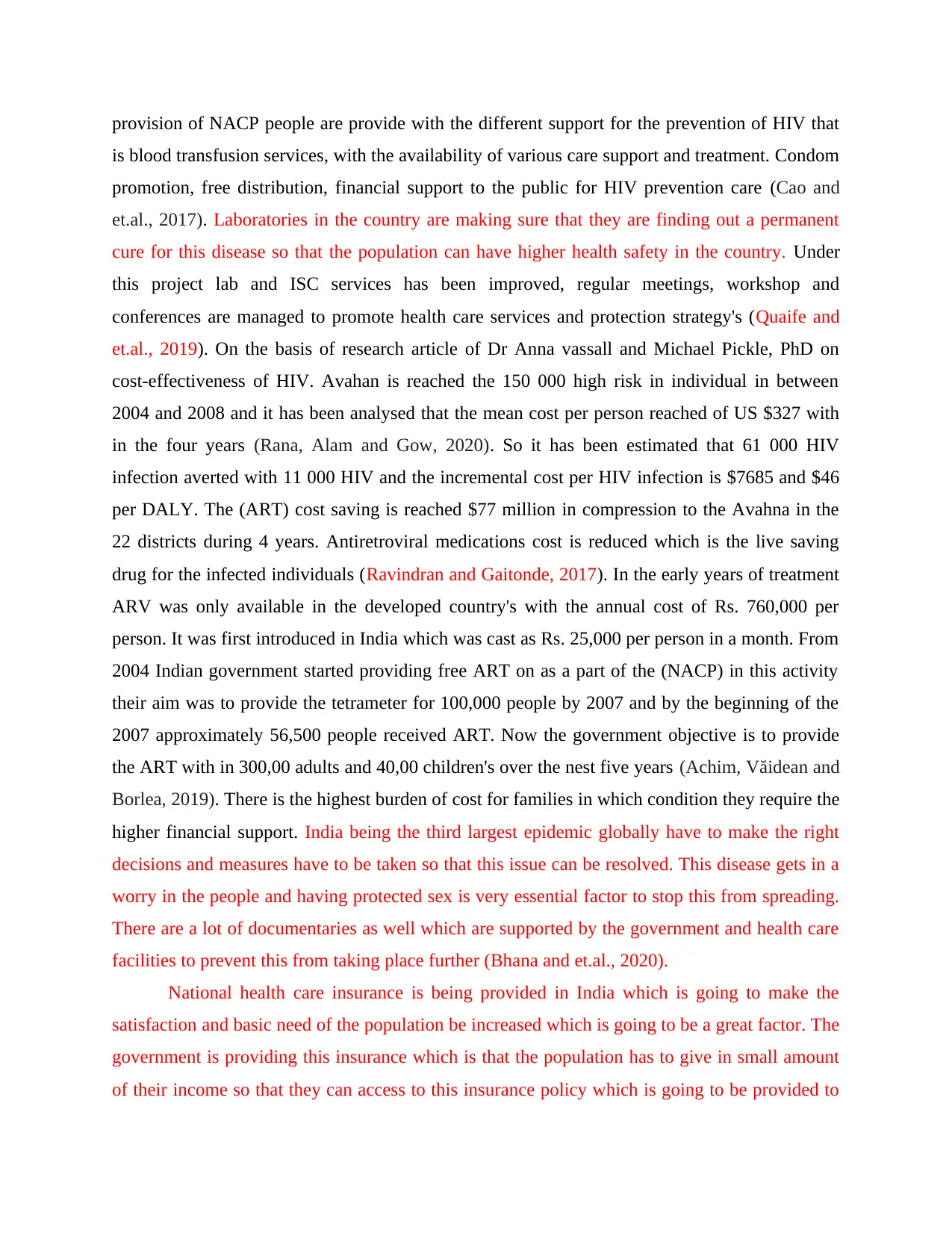
provision of NACP people are provide with the different support for the prevention of HIV that
is blood transfusion services, with the availability of various care support and treatment. Condom
promotion, free distribution, financial support to the public for HIV prevention care (Cao and
et.al., 2017). Laboratories in the country are making sure that they are finding out a permanent
cure for this disease so that the population can have higher health safety in the country. Under
this project lab and ISC services has been improved, regular meetings, workshop and
conferences are managed to promote health care services and protection strategy's (Quaife and
et.al., 2019). On the basis of research article of Dr Anna vassall and Michael Pickle, PhD on
cost-effectiveness of HIV. Avahan is reached the 150 000 high risk in individual in between
2004 and 2008 and it has been analysed that the mean cost per person reached of US $327 with
in the four years (Rana, Alam and Gow, 2020). So it has been estimated that 61 000 HIV
infection averted with 11 000 HIV and the incremental cost per HIV infection is $7685 and $46
per DALY. The (ART) cost saving is reached $77 million in compression to the Avahna in the
22 districts during 4 years. Antiretroviral medications cost is reduced which is the live saving
drug for the infected individuals (Ravindran and Gaitonde, 2017). In the early years of treatment
ARV was only available in the developed country's with the annual cost of Rs. 760,000 per
person. It was first introduced in India which was cast as Rs. 25,000 per person in a month. From
2004 Indian government started providing free ART on as a part of the (NACP) in this activity
their aim was to provide the tetrameter for 100,000 people by 2007 and by the beginning of the
2007 approximately 56,500 people received ART. Now the government objective is to provide
the ART with in 300,00 adults and 40,00 children's over the nest five years (Achim, Văidean and
Borlea, 2019). There is the highest burden of cost for families in which condition they require the
higher financial support. India being the third largest epidemic globally have to make the right
decisions and measures have to be taken so that this issue can be resolved. This disease gets in a
worry in the people and having protected sex is very essential factor to stop this from spreading.
There are a lot of documentaries as well which are supported by the government and health care
facilities to prevent this from taking place further (Bhana and et.al., 2020).
National health care insurance is being provided in India which is going to make the
satisfaction and basic need of the population be increased which is going to be a great factor. The
government is providing this insurance which is that the population has to give in small amount
of their income so that they can access to this insurance policy which is going to be provided to
is blood transfusion services, with the availability of various care support and treatment. Condom
promotion, free distribution, financial support to the public for HIV prevention care (Cao and
et.al., 2017). Laboratories in the country are making sure that they are finding out a permanent
cure for this disease so that the population can have higher health safety in the country. Under
this project lab and ISC services has been improved, regular meetings, workshop and
conferences are managed to promote health care services and protection strategy's (Quaife and
et.al., 2019). On the basis of research article of Dr Anna vassall and Michael Pickle, PhD on
cost-effectiveness of HIV. Avahan is reached the 150 000 high risk in individual in between
2004 and 2008 and it has been analysed that the mean cost per person reached of US $327 with
in the four years (Rana, Alam and Gow, 2020). So it has been estimated that 61 000 HIV
infection averted with 11 000 HIV and the incremental cost per HIV infection is $7685 and $46
per DALY. The (ART) cost saving is reached $77 million in compression to the Avahna in the
22 districts during 4 years. Antiretroviral medications cost is reduced which is the live saving
drug for the infected individuals (Ravindran and Gaitonde, 2017). In the early years of treatment
ARV was only available in the developed country's with the annual cost of Rs. 760,000 per
person. It was first introduced in India which was cast as Rs. 25,000 per person in a month. From
2004 Indian government started providing free ART on as a part of the (NACP) in this activity
their aim was to provide the tetrameter for 100,000 people by 2007 and by the beginning of the
2007 approximately 56,500 people received ART. Now the government objective is to provide
the ART with in 300,00 adults and 40,00 children's over the nest five years (Achim, Văidean and
Borlea, 2019). There is the highest burden of cost for families in which condition they require the
higher financial support. India being the third largest epidemic globally have to make the right
decisions and measures have to be taken so that this issue can be resolved. This disease gets in a
worry in the people and having protected sex is very essential factor to stop this from spreading.
There are a lot of documentaries as well which are supported by the government and health care
facilities to prevent this from taking place further (Bhana and et.al., 2020).
National health care insurance is being provided in India which is going to make the
satisfaction and basic need of the population be increased which is going to be a great factor. The
government is providing this insurance which is that the population has to give in small amount
of their income so that they can access to this insurance policy which is going to be provided to
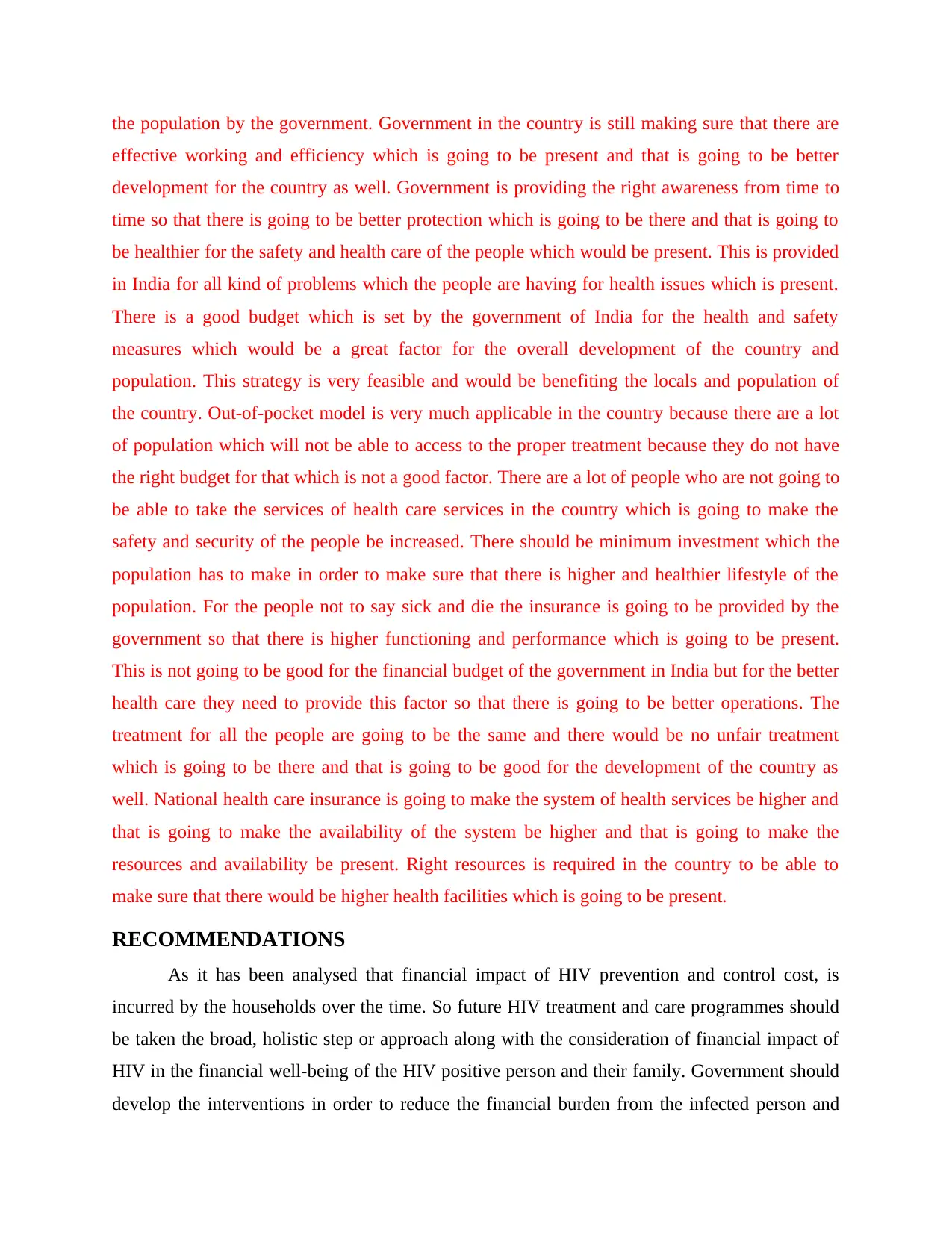
the population by the government. Government in the country is still making sure that there are
effective working and efficiency which is going to be present and that is going to be better
development for the country as well. Government is providing the right awareness from time to
time so that there is going to be better protection which is going to be there and that is going to
be healthier for the safety and health care of the people which would be present. This is provided
in India for all kind of problems which the people are having for health issues which is present.
There is a good budget which is set by the government of India for the health and safety
measures which would be a great factor for the overall development of the country and
population. This strategy is very feasible and would be benefiting the locals and population of
the country. Out-of-pocket model is very much applicable in the country because there are a lot
of population which will not be able to access to the proper treatment because they do not have
the right budget for that which is not a good factor. There are a lot of people who are not going to
be able to take the services of health care services in the country which is going to make the
safety and security of the people be increased. There should be minimum investment which the
population has to make in order to make sure that there is higher and healthier lifestyle of the
population. For the people not to say sick and die the insurance is going to be provided by the
government so that there is higher functioning and performance which is going to be present.
This is not going to be good for the financial budget of the government in India but for the better
health care they need to provide this factor so that there is going to be better operations. The
treatment for all the people are going to be the same and there would be no unfair treatment
which is going to be there and that is going to be good for the development of the country as
well. National health care insurance is going to make the system of health services be higher and
that is going to make the availability of the system be higher and that is going to make the
resources and availability be present. Right resources is required in the country to be able to
make sure that there would be higher health facilities which is going to be present.
RECOMMENDATIONS
As it has been analysed that financial impact of HIV prevention and control cost, is
incurred by the households over the time. So future HIV treatment and care programmes should
be taken the broad, holistic step or approach along with the consideration of financial impact of
HIV in the financial well-being of the HIV positive person and their family. Government should
develop the interventions in order to reduce the financial burden from the infected person and
effective working and efficiency which is going to be present and that is going to be better
development for the country as well. Government is providing the right awareness from time to
time so that there is going to be better protection which is going to be there and that is going to
be healthier for the safety and health care of the people which would be present. This is provided
in India for all kind of problems which the people are having for health issues which is present.
There is a good budget which is set by the government of India for the health and safety
measures which would be a great factor for the overall development of the country and
population. This strategy is very feasible and would be benefiting the locals and population of
the country. Out-of-pocket model is very much applicable in the country because there are a lot
of population which will not be able to access to the proper treatment because they do not have
the right budget for that which is not a good factor. There are a lot of people who are not going to
be able to take the services of health care services in the country which is going to make the
safety and security of the people be increased. There should be minimum investment which the
population has to make in order to make sure that there is higher and healthier lifestyle of the
population. For the people not to say sick and die the insurance is going to be provided by the
government so that there is higher functioning and performance which is going to be present.
This is not going to be good for the financial budget of the government in India but for the better
health care they need to provide this factor so that there is going to be better operations. The
treatment for all the people are going to be the same and there would be no unfair treatment
which is going to be there and that is going to be good for the development of the country as
well. National health care insurance is going to make the system of health services be higher and
that is going to make the availability of the system be higher and that is going to make the
resources and availability be present. Right resources is required in the country to be able to
make sure that there would be higher health facilities which is going to be present.
RECOMMENDATIONS
As it has been analysed that financial impact of HIV prevention and control cost, is
incurred by the households over the time. So future HIV treatment and care programmes should
be taken the broad, holistic step or approach along with the consideration of financial impact of
HIV in the financial well-being of the HIV positive person and their family. Government should
develop the interventions in order to reduce the financial burden from the infected person and
⊘ This is a preview!⊘
Do you want full access?
Subscribe today to unlock all pages.

Trusted by 1+ million students worldwide
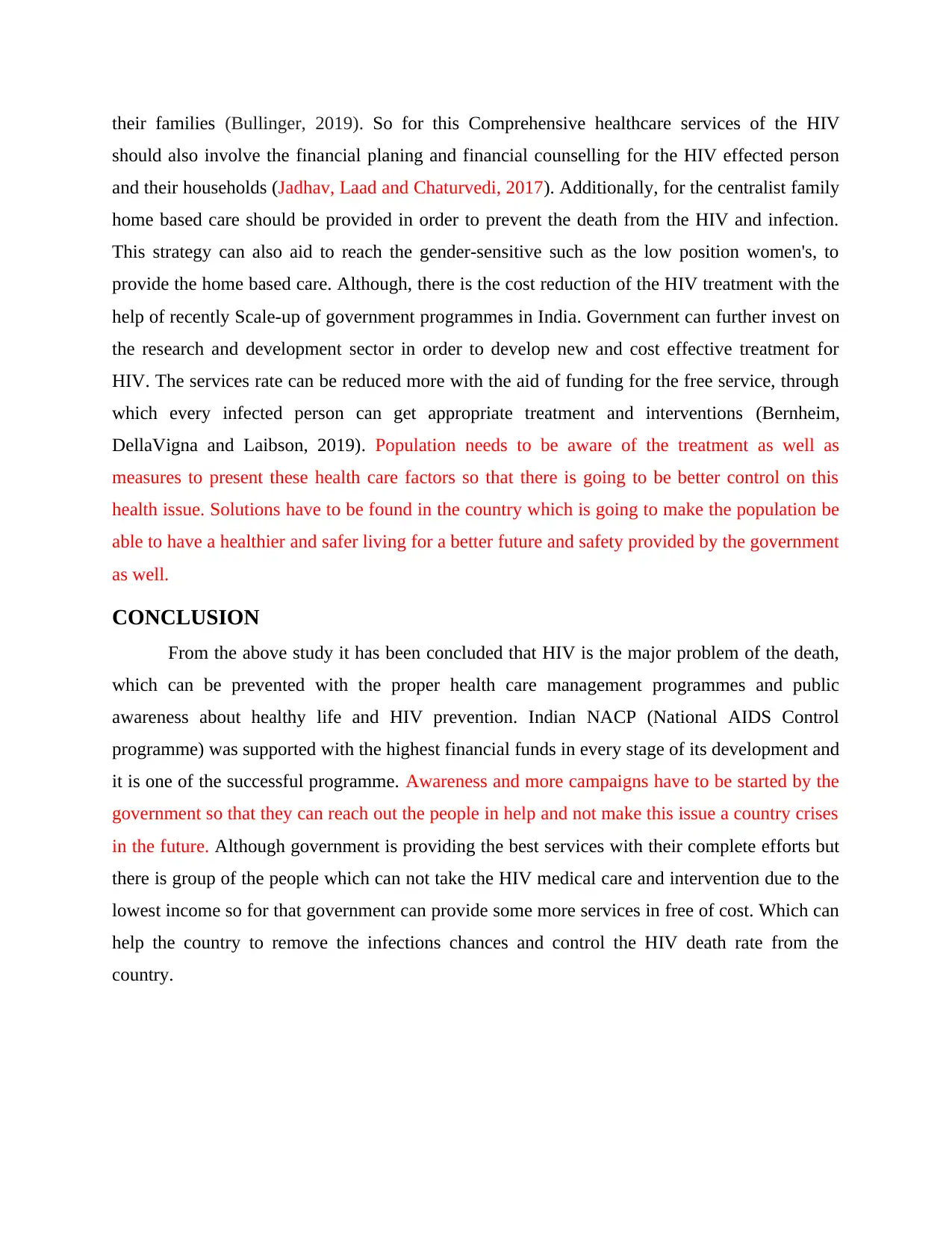
their families (Bullinger, 2019). So for this Comprehensive healthcare services of the HIV
should also involve the financial planing and financial counselling for the HIV effected person
and their households (Jadhav, Laad and Chaturvedi, 2017). Additionally, for the centralist family
home based care should be provided in order to prevent the death from the HIV and infection.
This strategy can also aid to reach the gender-sensitive such as the low position women's, to
provide the home based care. Although, there is the cost reduction of the HIV treatment with the
help of recently Scale-up of government programmes in India. Government can further invest on
the research and development sector in order to develop new and cost effective treatment for
HIV. The services rate can be reduced more with the aid of funding for the free service, through
which every infected person can get appropriate treatment and interventions (Bernheim,
DellaVigna and Laibson, 2019). Population needs to be aware of the treatment as well as
measures to present these health care factors so that there is going to be better control on this
health issue. Solutions have to be found in the country which is going to make the population be
able to have a healthier and safer living for a better future and safety provided by the government
as well.
CONCLUSION
From the above study it has been concluded that HIV is the major problem of the death,
which can be prevented with the proper health care management programmes and public
awareness about healthy life and HIV prevention. Indian NACP (National AIDS Control
programme) was supported with the highest financial funds in every stage of its development and
it is one of the successful programme. Awareness and more campaigns have to be started by the
government so that they can reach out the people in help and not make this issue a country crises
in the future. Although government is providing the best services with their complete efforts but
there is group of the people which can not take the HIV medical care and intervention due to the
lowest income so for that government can provide some more services in free of cost. Which can
help the country to remove the infections chances and control the HIV death rate from the
country.
should also involve the financial planing and financial counselling for the HIV effected person
and their households (Jadhav, Laad and Chaturvedi, 2017). Additionally, for the centralist family
home based care should be provided in order to prevent the death from the HIV and infection.
This strategy can also aid to reach the gender-sensitive such as the low position women's, to
provide the home based care. Although, there is the cost reduction of the HIV treatment with the
help of recently Scale-up of government programmes in India. Government can further invest on
the research and development sector in order to develop new and cost effective treatment for
HIV. The services rate can be reduced more with the aid of funding for the free service, through
which every infected person can get appropriate treatment and interventions (Bernheim,
DellaVigna and Laibson, 2019). Population needs to be aware of the treatment as well as
measures to present these health care factors so that there is going to be better control on this
health issue. Solutions have to be found in the country which is going to make the population be
able to have a healthier and safer living for a better future and safety provided by the government
as well.
CONCLUSION
From the above study it has been concluded that HIV is the major problem of the death,
which can be prevented with the proper health care management programmes and public
awareness about healthy life and HIV prevention. Indian NACP (National AIDS Control
programme) was supported with the highest financial funds in every stage of its development and
it is one of the successful programme. Awareness and more campaigns have to be started by the
government so that they can reach out the people in help and not make this issue a country crises
in the future. Although government is providing the best services with their complete efforts but
there is group of the people which can not take the HIV medical care and intervention due to the
lowest income so for that government can provide some more services in free of cost. Which can
help the country to remove the infections chances and control the HIV death rate from the
country.
Paraphrase This Document
Need a fresh take? Get an instant paraphrase of this document with our AI Paraphraser
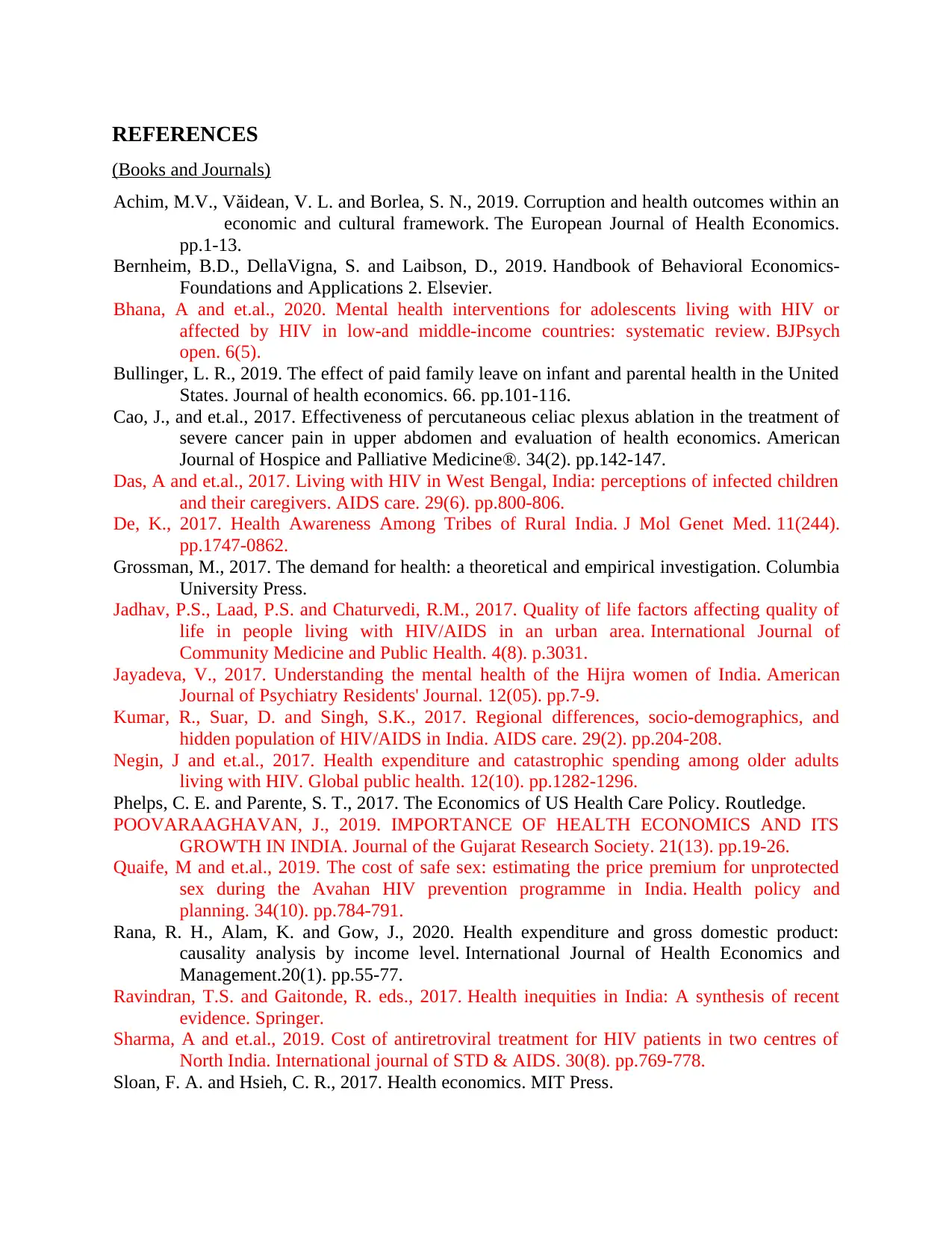
REFERENCES
(Books and Journals)
Achim, M.V., Văidean, V. L. and Borlea, S. N., 2019. Corruption and health outcomes within an
economic and cultural framework. The European Journal of Health Economics.
pp.1-13.
Bernheim, B.D., DellaVigna, S. and Laibson, D., 2019. Handbook of Behavioral Economics-
Foundations and Applications 2. Elsevier.
Bhana, A and et.al., 2020. Mental health interventions for adolescents living with HIV or
affected by HIV in low-and middle-income countries: systematic review. BJPsych
open. 6(5).
Bullinger, L. R., 2019. The effect of paid family leave on infant and parental health in the United
States. Journal of health economics. 66. pp.101-116.
Cao, J., and et.al., 2017. Effectiveness of percutaneous celiac plexus ablation in the treatment of
severe cancer pain in upper abdomen and evaluation of health economics. American
Journal of Hospice and Palliative Medicine®. 34(2). pp.142-147.
Das, A and et.al., 2017. Living with HIV in West Bengal, India: perceptions of infected children
and their caregivers. AIDS care. 29(6). pp.800-806.
De, K., 2017. Health Awareness Among Tribes of Rural India. J Mol Genet Med. 11(244).
pp.1747-0862.
Grossman, M., 2017. The demand for health: a theoretical and empirical investigation. Columbia
University Press.
Jadhav, P.S., Laad, P.S. and Chaturvedi, R.M., 2017. Quality of life factors affecting quality of
life in people living with HIV/AIDS in an urban area. International Journal of
Community Medicine and Public Health. 4(8). p.3031.
Jayadeva, V., 2017. Understanding the mental health of the Hijra women of India. American
Journal of Psychiatry Residents' Journal. 12(05). pp.7-9.
Kumar, R., Suar, D. and Singh, S.K., 2017. Regional differences, socio-demographics, and
hidden population of HIV/AIDS in India. AIDS care. 29(2). pp.204-208.
Negin, J and et.al., 2017. Health expenditure and catastrophic spending among older adults
living with HIV. Global public health. 12(10). pp.1282-1296.
Phelps, C. E. and Parente, S. T., 2017. The Economics of US Health Care Policy. Routledge.
POOVARAAGHAVAN, J., 2019. IMPORTANCE OF HEALTH ECONOMICS AND ITS
GROWTH IN INDIA. Journal of the Gujarat Research Society. 21(13). pp.19-26.
Quaife, M and et.al., 2019. The cost of safe sex: estimating the price premium for unprotected
sex during the Avahan HIV prevention programme in India. Health policy and
planning. 34(10). pp.784-791.
Rana, R. H., Alam, K. and Gow, J., 2020. Health expenditure and gross domestic product:
causality analysis by income level. International Journal of Health Economics and
Management.20(1). pp.55-77.
Ravindran, T.S. and Gaitonde, R. eds., 2017. Health inequities in India: A synthesis of recent
evidence. Springer.
Sharma, A and et.al., 2019. Cost of antiretroviral treatment for HIV patients in two centres of
North India. International journal of STD & AIDS. 30(8). pp.769-778.
Sloan, F. A. and Hsieh, C. R., 2017. Health economics. MIT Press.
(Books and Journals)
Achim, M.V., Văidean, V. L. and Borlea, S. N., 2019. Corruption and health outcomes within an
economic and cultural framework. The European Journal of Health Economics.
pp.1-13.
Bernheim, B.D., DellaVigna, S. and Laibson, D., 2019. Handbook of Behavioral Economics-
Foundations and Applications 2. Elsevier.
Bhana, A and et.al., 2020. Mental health interventions for adolescents living with HIV or
affected by HIV in low-and middle-income countries: systematic review. BJPsych
open. 6(5).
Bullinger, L. R., 2019. The effect of paid family leave on infant and parental health in the United
States. Journal of health economics. 66. pp.101-116.
Cao, J., and et.al., 2017. Effectiveness of percutaneous celiac plexus ablation in the treatment of
severe cancer pain in upper abdomen and evaluation of health economics. American
Journal of Hospice and Palliative Medicine®. 34(2). pp.142-147.
Das, A and et.al., 2017. Living with HIV in West Bengal, India: perceptions of infected children
and their caregivers. AIDS care. 29(6). pp.800-806.
De, K., 2017. Health Awareness Among Tribes of Rural India. J Mol Genet Med. 11(244).
pp.1747-0862.
Grossman, M., 2017. The demand for health: a theoretical and empirical investigation. Columbia
University Press.
Jadhav, P.S., Laad, P.S. and Chaturvedi, R.M., 2017. Quality of life factors affecting quality of
life in people living with HIV/AIDS in an urban area. International Journal of
Community Medicine and Public Health. 4(8). p.3031.
Jayadeva, V., 2017. Understanding the mental health of the Hijra women of India. American
Journal of Psychiatry Residents' Journal. 12(05). pp.7-9.
Kumar, R., Suar, D. and Singh, S.K., 2017. Regional differences, socio-demographics, and
hidden population of HIV/AIDS in India. AIDS care. 29(2). pp.204-208.
Negin, J and et.al., 2017. Health expenditure and catastrophic spending among older adults
living with HIV. Global public health. 12(10). pp.1282-1296.
Phelps, C. E. and Parente, S. T., 2017. The Economics of US Health Care Policy. Routledge.
POOVARAAGHAVAN, J., 2019. IMPORTANCE OF HEALTH ECONOMICS AND ITS
GROWTH IN INDIA. Journal of the Gujarat Research Society. 21(13). pp.19-26.
Quaife, M and et.al., 2019. The cost of safe sex: estimating the price premium for unprotected
sex during the Avahan HIV prevention programme in India. Health policy and
planning. 34(10). pp.784-791.
Rana, R. H., Alam, K. and Gow, J., 2020. Health expenditure and gross domestic product:
causality analysis by income level. International Journal of Health Economics and
Management.20(1). pp.55-77.
Ravindran, T.S. and Gaitonde, R. eds., 2017. Health inequities in India: A synthesis of recent
evidence. Springer.
Sharma, A and et.al., 2019. Cost of antiretroviral treatment for HIV patients in two centres of
North India. International journal of STD & AIDS. 30(8). pp.769-778.
Sloan, F. A. and Hsieh, C. R., 2017. Health economics. MIT Press.
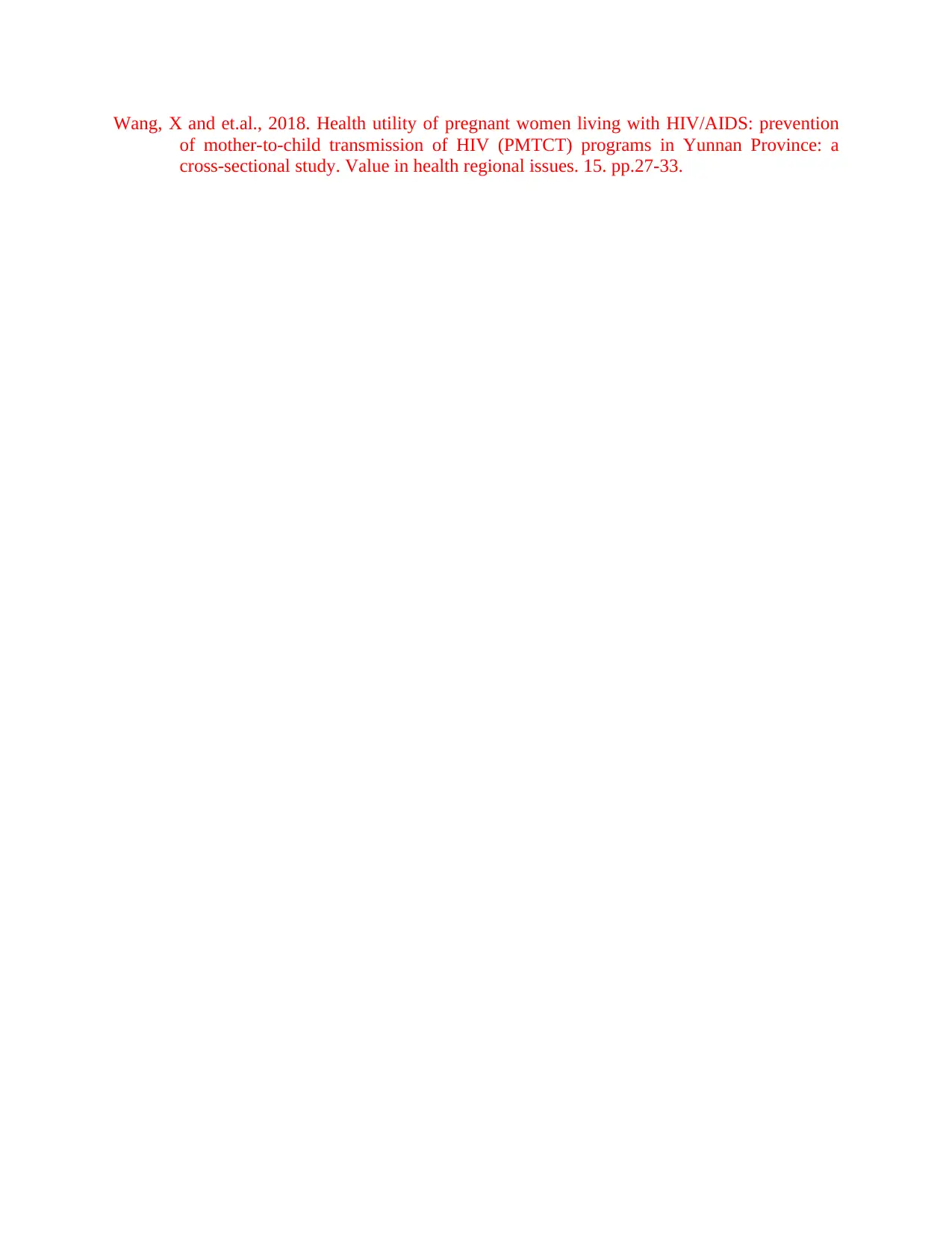
Wang, X and et.al., 2018. Health utility of pregnant women living with HIV/AIDS: prevention
of mother-to-child transmission of HIV (PMTCT) programs in Yunnan Province: a
cross-sectional study. Value in health regional issues. 15. pp.27-33.
of mother-to-child transmission of HIV (PMTCT) programs in Yunnan Province: a
cross-sectional study. Value in health regional issues. 15. pp.27-33.
⊘ This is a preview!⊘
Do you want full access?
Subscribe today to unlock all pages.

Trusted by 1+ million students worldwide
1 out of 9
Related Documents
Your All-in-One AI-Powered Toolkit for Academic Success.
+13062052269
info@desklib.com
Available 24*7 on WhatsApp / Email
![[object Object]](/_next/static/media/star-bottom.7253800d.svg)
Unlock your academic potential
Copyright © 2020–2025 A2Z Services. All Rights Reserved. Developed and managed by ZUCOL.





